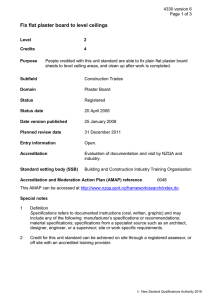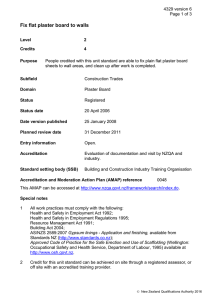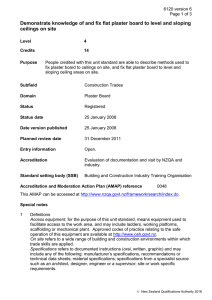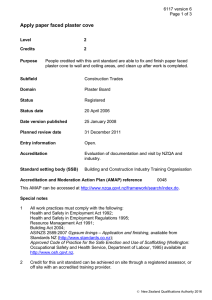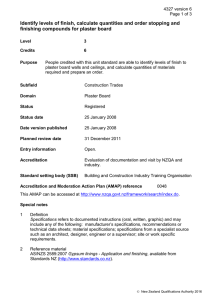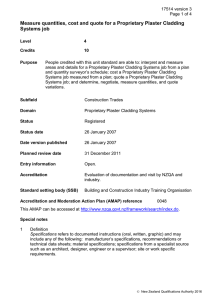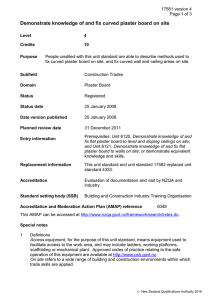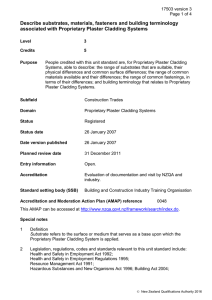Demonstrate knowledge of Proprietary Plaster Cladding Systems trade tools
advertisement
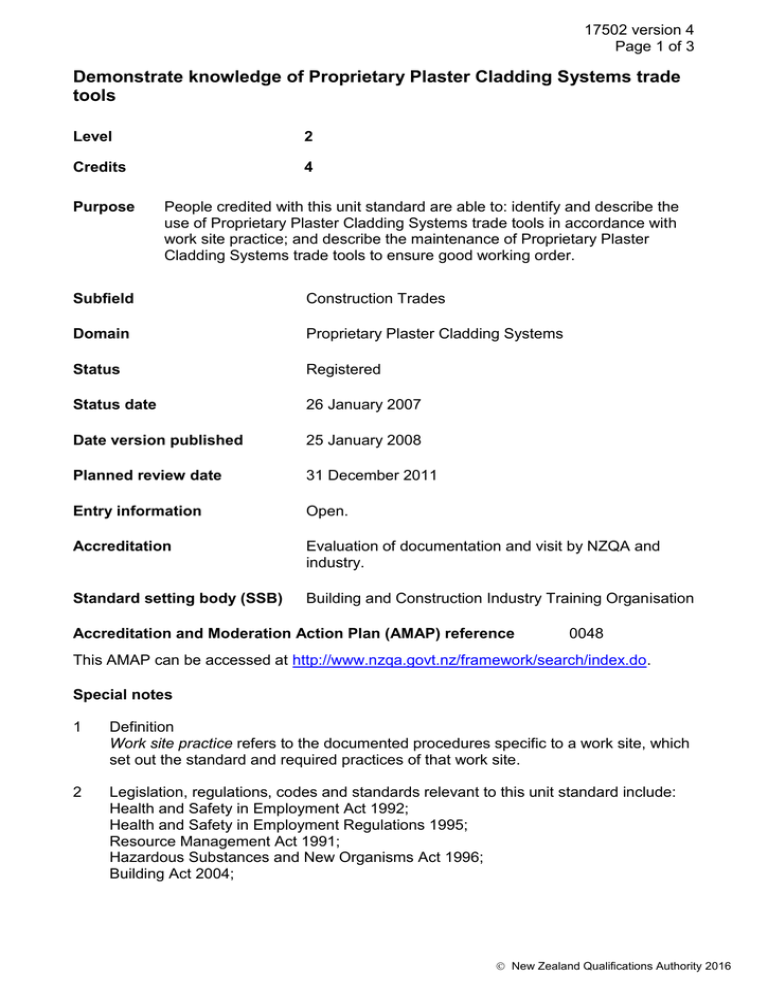
17502 version 4 Page 1 of 3 Demonstrate knowledge of Proprietary Plaster Cladding Systems trade tools Level 2 Credits 4 Purpose People credited with this unit standard are able to: identify and describe the use of Proprietary Plaster Cladding Systems trade tools in accordance with work site practice; and describe the maintenance of Proprietary Plaster Cladding Systems trade tools to ensure good working order. Subfield Construction Trades Domain Proprietary Plaster Cladding Systems Status Registered Status date 26 January 2007 Date version published 25 January 2008 Planned review date 31 December 2011 Entry information Open. Accreditation Evaluation of documentation and visit by NZQA and industry. Standard setting body (SSB) Building and Construction Industry Training Organisation Accreditation and Moderation Action Plan (AMAP) reference 0048 This AMAP can be accessed at http://www.nzqa.govt.nz/framework/search/index.do. Special notes 1 Definition Work site practice refers to the documented procedures specific to a work site, which set out the standard and required practices of that work site. 2 Legislation, regulations, codes and standards relevant to this unit standard include: Health and Safety in Employment Act 1992; Health and Safety in Employment Regulations 1995; Resource Management Act 1991; Hazardous Substances and New Organisms Act 1996; Building Act 2004; New Zealand Qualifications Authority 2016 17502 version 4 Page 2 of 3 NZS 4218:2004 Energy efficiency – Small building envelope and NZS 3604:1999 Timber Framed Buildings, available from Standards NZ (http://www.standards.co.nz); New Zealand Building Code; Territorial Authorities’ building regulations. Elements and performance criteria Element 1 Identify and describe the use of Proprietary Plaster Cladding Systems trade tools in accordance with work site practice. Range hand tools – tape measure, straight edge, level, string line, shears, scribe, saw, rasp, hammer, trowel, corner trowel, broadknife, float, sponge, masking machine, cartridge gun, knife, hawke, chalkline, screed, square, sharpening stone, staple gun; power tools – drill, grinder, saw, hot knife, mixer, compressor and spray gun, plaster pump, pneumatic nailer. Performance criteria 1.1 Tools are described in terms of their capabilities and limitations. 1.2 Use of tools is described in terms of the work operation to be completed. 1.3 Use of tools is described in terms of safety requirements. Range 1.4 hazards, risks, precautions. Tools are identified in relation to proprietary plastering requirements. Element 2 Describe the maintenance of Proprietary Plaster Cladding Systems trade tools to ensure good working order. Range hand tools – tape measure, straight edge, level, string line, shears, scribe, saw, rasp, hammer, trowel, corner trowel, broadknife, float, sponge, masking machine, cartridge gun, knife, hawke, chalkline, screed, square, sharpening stone, staple gun; power tools – drill, grinder, saw, hot knife, mixer, compressor and spray gun, plaster pump, pneumatic nailer. Performance criteria 2.1 Care and maintenance of tools are described as recommended by the manufacturer. 2.2 Cutting edges and points are evaluated to determine the cutting efficiency in accordance with manufacturer’s recommendations. New Zealand Qualifications Authority 2016 17502 version 4 Page 3 of 3 2.3 Methods for maintaining tools in good working order are described and are consistent with work site practice. Please note Providers must be accredited by NZQA, or an inter-institutional body with delegated authority for quality assurance, before they can report credits from assessment against unit standards or deliver courses of study leading to that assessment. Industry Training Organisations must be accredited by NZQA before they can register credits from assessment against unit standards. Accredited providers and Industry Training Organisations assessing against unit standards must engage with the moderation system that applies to those standards. Accreditation requirements and an outline of the moderation system that applies to this standard are outlined in the Accreditation and Moderation Action Plan (AMAP). The AMAP also includes useful information about special requirements for organisations wishing to develop education and training programmes, such as minimum qualifications for tutors and assessors, and special resource requirements. Comments on this unit standard Please contact the Building and Construction Industry Training Organisation national.office@bcito.org.nz if you wish to suggest changes to the content of this unit standard. New Zealand Qualifications Authority 2016
